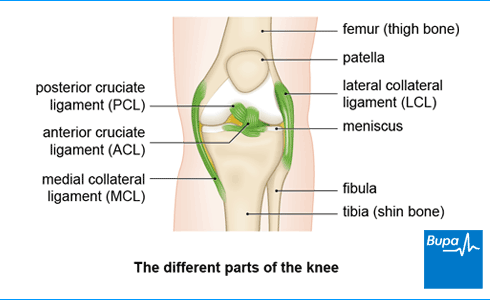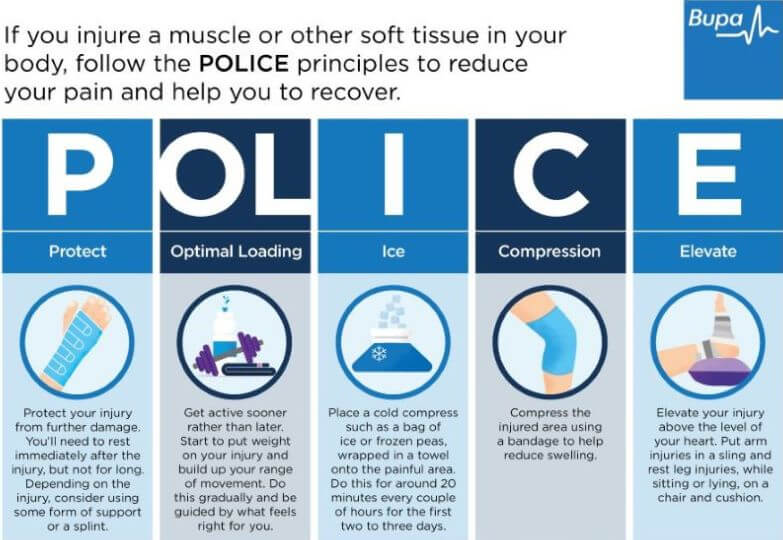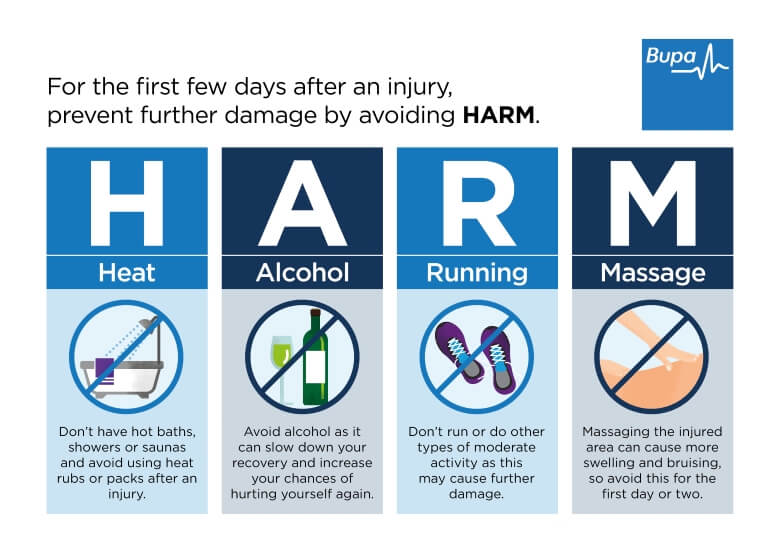Lateral collateral ligament (LCL) injury
Your health expert: Mr Damian McClelland, Trauma and Orthopaedic Consultant, and Clinical Director for Musculoskeletal Services at Bupa
Content editor review by Rachael Mayfield-Blake, May 2023
Next review due May 2026
A lateral collateral ligament (LCL) injury happens when you damage one of the ligaments in your knee. The LCL lies on the outer side of your knee joint and connects your thigh bone (femur) to the small bone in your lower leg (fibula).

About lateral collateral ligament injury
The LCL is sometimes called the fibular collateral ligament. Along with the other ligaments in your knee, your LCL keeps your knee stable. Your LCL and your medial collateral ligament (MCL) control the sideways movement of your knee.
An LCL injury can be a partial tear, a complete tear, or a stretched ligament. When the knee ligament is stretched but still intact, this is called an LCL sprain. Sprains are given different grades depending on how severe they are. You may injure other ligaments and tendons in your knee at the same time. For example, you could also injure your anterior cruciate ligament (ACL ). Or you could injure your posterior cruciate ligament (PCL) as well as other parts of your knee such as your cartilage (meniscus).
Causes of lateral collateral ligament injury
A lateral collateral ligament (LCL) injury is usually caused by your knee being pushed outwards (away from your other knee). This may happen if you get a blow to the inside of your leg, which can happen during contact sports such as football. You can also injure your LCL by twisting on the side of your foot or extending your knee beyond its normal range of movement.
You may also injure your LCL along with other ligaments in your knee if you have an accident. For example, if you fall or have a car accident.
Symptoms of lateral collateral ligament injury
The main symptom of an LCL injury is pain on the outside of your knee. And you may have some bruising and swelling in the area.
Depending on the severity of your injury, your knee may also feel a little unstable when you move it from side to side. It might feel as if it’s going to give way. You might find it difficult to walk on uneven ground.
You may damage a nerve around your knee at the same time as your LCL. If this happens, you may have some numbness and weakness around your foot and ankle.
Self-help for lateral collateral ligament injury
If you injure your knee, you should follow the POLICE procedure, which stands for the following.
Protect. Protect your injury from further damage. Rest immediately after the injury but not for long. Consider using some form of support or crutches.
Optimal Loading. Get active sooner rather than later. Start to put weight on your knee and build up your range of movement. Do this gradually – be guided by what feels right for you.
Ice. Place a cold compress such as a bag of ice or frozen peas wrapped in a towel onto your knee. Do this for a maximum of 15 minutes every couple of hours for the first two to three days.
Compression. Compress your knee using a bandage to help reduce swelling.
Elevation. Elevate your knee above the level of your heart to reduce swelling. Sit or lie on a chair and use a cushion to raise your leg.
Infographic: POLICE principles
Bupa's POLICE infographic (PDF, 0.5 MB) below illustrates the ‘POLICE principles’ to reduce your pain and help you to recover.

There are certain things you should avoid in the first three days after your injury so you don’t damage your knee further. These can be remembered as HARM, which stands for the following.
H – Heat. Don’t have hot baths, showers or saunas, and avoid heat packs and rubs.
A – Alcohol. Drinking alcohol can slow down your recovery and mask your symptoms – increasing the risk that you’ll injure yourself again.
R – Running. Don’t run or do any other form of moderate exercise.
M – Massage. Massaging the affected areas can cause more swelling and damage, so avoid this for the first day or two.
Infographic: HARM principle
Bupa's HARM infographic (PDF, 0.6 MB) below illustrates the ‘HARM principle' of things you should avoid doing in the first three days after your injury.

Treatment for lateral collateral ligament injury
If you have a significant injury to your knee, you’ll usually need to go to A&E with this kind of injury. They’ll examine you and take some X-rays of your knee or sometimes an MRI scan . They may then refer you to an acute knee clinic, which will organise any investigations and treatment you need.
Your lateral collateral ligament injury treatment will depend on how severe the damage is, and if you’ve injured any other parts of your knee. The initial treatment will be to control your pain and swelling using the POLICE and HARM self-help measures (for more information, see our self-help section). Further treatments include knee bracing, physiotherapy , medicines, and sometimes, surgery.
You may see an orthopaedic surgeon (a doctor who specialises in bone surgery) or a sports medicine professional such as a sports doctor or physiotherapist. There are different treatments that your doctor or physiotherapist may suggest, and a lot that you can do yourself to help your recovery.
Medicines for lateral collateral ligament injury
You can take over-the-counter painkillers such as ibuprofen to help relieve any pain. Your doctor may prescribe stronger painkillers if your pain is really bad. As well as easing your pain, non-steroidal anti-inflammatory drugs (NSAIDs) such as ibuprofen may help to reduce inflammation and swelling. Always read the patient information that comes with your medicine and if you have questions, ask your pharmacist or GP for advice.
Physiotherapy for lateral collateral ligament injury
Your physiotherapist will carefully assess your knee and then plan a programme of lateral collateral ligament exercises to suit your individual needs. The physiotherapy programme will be designed to help your knee recover its full range of movement and its strength and stability. This should help you get full function back in your knee and return to your usual sports and activities. Make sure you do the exercises because they are an important part of your recovery.
Often, treatment with physiotherapy and leg bracing will be all you need if you have a LCL injury. You may recover and return to your usual activities and sports after four to 10 weeks but ask your physiotherapist for advice specific for you.
Surgery for lateral collateral ligament injury
Most people with a mild or moderate LCL injury won’t need surgery. If your LCL injury is more severe, it’s likely that you’ll have damaged other parts of your knee too. If this happens to you, surgery may be necessary to repair your LCL and help to restore stability in your knee.
It can take about around four months to recover from surgery and to be able to put weight on your knee. Ask your doctor about surgery, and if it could help you.
Looking for physiotherapy?
You can access a range of treatments on a pay as you go basis, including physiotherapy.
To book or to make an enquiry, call us on 0370 218 6528∧
A lateral collateral ligament (LCL) injury will feel painful on the outside of your knee. Your knee may also feel a little unstable when you move it from side to side (depending on how severe your injury is). If you damage a nerve in your knee at the same time, your foot and ankle may feel numb and weak.
For more information, See our section on symptoms of lateral collateral ligament injury.
It’s hard to know but it’s possible that your depression may come back after treatment. You’re more at risk of a relapse the more episodes of depression you’ve had. There are several things you can do to help prevent this. For example, you may need to continue treatment with antidepressants or take another medicine. Or you could try a psychological treatment such as CBT or mindfulness-based therapy.
See our section: treatment of depression for more information.
Symptoms of depression include feeling down or hopeless and losing interest or pleasure in activities you would normally enjoy. While depression affects everyone in different ways, other symptoms can include feeling tired and worthless – you may lose your confidence in things. Depression can also affect your sleep and concentration.
See our section: symptoms of depression for more information.
The causes of depression can vary and often it’s a combination of different things. For example, you may get depressed after you lose your job or because of pain from having a long-term or serious physical health problem. Depression can also run in families.
See our section: causes of depression for more information.
Posterior cruciate ligament (PCL) injury
With a PCL injury, it’s common to injure other ligaments, or other parts of your knee, at the same time.
Anterior cruciate ligament (ACL) injury
An ACL injury can be a partial or a complete tear, an overstretch, or a detachment of the ligament.
Medial collateral ligament (MCL) injury
The MCL is the most commonly injured knee ligament. It often gets injured during sports such as rugby.
Meniscal tear
Tears of the menisci are a common injury. When people talk about a ‘torn cartilage’ in their knee they usually mean a meniscus injury.
Patellar tendinopathy (jumper's knee)
Patellar tendinopathy is also called ‘jumper’s knee’ because the injury commonly occurs during sports that involve jumping, such as basketball.
Patellofemoral pain syndrome
Patellofemoral pain syndrome is sometimes called ‘runner’s knee’ because it’s particularly common in people who run or do other sports.
Did our Lateral collateral ligament (LCL) injury information help you?
We’d love to hear what you think.∧ Our short survey takes just a few minutes to complete and helps us to keep improving our health information.
∧ The health information on this page is intended for informational purposes only. We do not endorse any commercial products, or include Bupa's fees for treatments and/or services. For more information about prices visit: www.bupa.co.uk/health/payg
This information was published by Bupa's Health Content Team and is based on reputable sources of medical evidence. It has been reviewed by appropriate medical or clinical professionals and deemed accurate on the date of review. Photos are only for illustrative purposes and do not reflect every presentation of a condition.
Any information about a treatment or procedure is generic, and does not necessarily describe that treatment or procedure as delivered by Bupa or its associated providers.
The information contained on this page and in any third party websites referred to on this page is not intended nor implied to be a substitute for professional medical advice nor is it intended to be for medical diagnosis or treatment. Third party websites are not owned or controlled by Bupa and any individual may be able to access and post messages on them. Bupa is not responsible for the content or availability of these third party websites. We do not accept advertising on this page.
- Knee ligament injuries. Patient. patient.info, last edited 16 August 2022
- Lateral collateral ligament knee injuries. Yaras RJ, O'Neill N, and Yaish AM. StatPearls Publishing. www.ncbi.nlm.nih.gov, last update 20 May 2022
- Lateral collateral knee ligament injury. Medscape. emedicine.medscape.com, updated 30 November 2020
- Bezuglov E, Khaitin V, Shoshorina M, et al. Sport-specific rehabilitation, but not PRP injections, might reduce the re-injury rate of muscle injuries in professional soccer players: a retrospective cohort study. J Funct Morphol Kinesiol 2022; 7(4):72. doi: 10.3390/jfmk7040072
- Sprains and strains. NICE Clinical Knowledge Summaries. cks.nice.org.uk, last revised September 2020
- Knee pain – assessment. NICE Clinical Knowledge Summaries. cks.nice.org.uk, last revised August 2022
- Non-steroidal anti-inflammatory drugs. NICE British National Formulary. bnf.nice.org.uk, last updated 27 April 2023
- Treatment for knee pain. Chartered Society of Physiotherapy. csp.org.uk, last reviewed 26 March 2020



